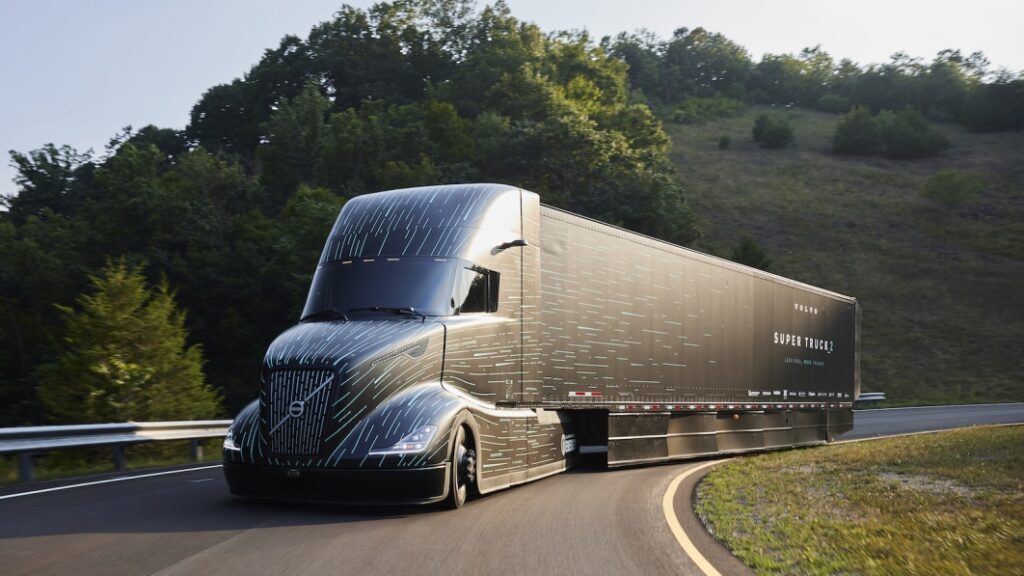Volvo's SuperTruck 2 looks ready to extend a ramp for K.I.T.T.

In 2009, the U.S. Department of Energy (DOE) entered a public-private partnership with willing Class 8 truck makers, the goal of the partnership to dramatically improve the freight efficiency of over-the-road (OTR) trucks. The term “freight efficiency” refers to freight-ton efficiency, a different metric than miles per gallon because it takes into account the weight of the truck; a lighter tractor-trailer can carry more weight before reaching the 80,000-pound legal maximum on most U.S. highways. Volvo, Daimler (which owns the Freightliner and Sterling brands), Navistar (International), and Peterbilt signed on the the partnership to develop what’s being called a SuperTruck. Volvo, Daimler, and International make their own engines, Peterbilt teamed up with Cummins, and all four found their own trailer manufacturers to work with. Those four makers debuted their first iterations of what’s being dubbed SuperTrucks about six years ago. This year has been all about SuperTruck 2, Volvo the last of the quartet to show what it’s achieved.
The goal for SuperTruck 1 was to achieve a 50% increase in freight efficiency compared to a 2009 baseline, the baseline in Volvo’s case being a 2009 VNL 670 tractor. The goal for SuperTruck 2 was another 50% improvement. Volvo said its internal goal was a 120% betterment compared to 2009, and that it exceeded the mark with a 134% increase. The company said the huge gains came primarily from aerodynamics: A wedge-shaped front with a smaller frontal area thanks to a smaller cooling package; the heavily curved, wraparound windshield; the tractor’s adjustable ride height; using camera for side mirrors; and adding a boat tail to the back of the trailer, plus enough fairings and skirts front-to-back to make the tractor and trailer look like a single unit when driving in a straight line.
Volvo did make changes to its rolling lab that aren’t likely to infiltrate the U.S. market anytime soon. It’s common for U.S. OTR trucks to use a 6×4 configuration, with two axles behind the cab, both driven. Volvo’s SuperTruck 2 went with a 4×2 setup common in Europe, using a single axle behind the cab, and fitted a composite driveshaft. Combined with making the chassis out of aluminum instead of steel, and trailer partner Wabash providing a lightweight aluminum van, the tractor-trailer combo weighed just 27,000 pounds. That’s about 7,000 pounds lighter than the 2017 Freightliner Cascadia and standard trailer I drove for six months in 2017, a massive trimming job. The truck maker also fitted smaller wheels, 19.5 inches instead of 22.5 inches, on low-friction Michelin tires.
SuperTruck 3 is already in development, but more importantly, all companies are working commercializing their advancements. Project engineers learned that just 100 hp could keep an aero-optimized truck rolling at a steady 65 mph on flat ground, as opposed to the roughly 300 hp necessary for a non-aero truck to do the same. Volvo’s already made changes to its D11 engine based on what it learned with SuperTruck 1. In the low-margin business of fleet trucking, these will be fractional improvements rolled out over time, but every fraction counts when a single over-the-road truck with a solo driver can easily cover 90,000 miles per year, while team drivers running around the clock do much more than that.
Based on my very brief experience as an OTR trucker, one of the greatest tools for improvement has one of the hardest roads to adoption: The deployable tails on the trailer that greatly reduce drag. Ten years ago, researchers said these boat tails cut aero drag by as much as 13%, equating to a 19% improvement in fuel economy. If the driver has to manually open them, though, drivers will forget, and the tails end up getting crushed when the driver backs into a freight dock. Boat tails used to be a common sight on the highway, then fleet managers got sick of having to replace crumpled units; now you hardly ever see them. Trailers, in general, get treated worse than rented mules, and fleet managers don’t like complexity back there.
It should also be noted that all of the SuperTruck teams have exceeded the project’s goals so far, following their own philosophies and finding their own balances of what’s possible versus what’s practical in the near- to mid-term. For instance, whereas Volvo went with a 4×2 configuration, Peterbilt went with a 6×4 configuration that uses lightweight 24.5-inch wheels, and employs an axle system that effectively replicates a liftable axle to turn a 6×4 into a 6×2. The Pete also places the driver front and center in the cab, like in the Tesla Semi. If you want to see what else is going on, Peterbilt’s freakishly tall and skinny SuperTruck 2 went on display last October, Daimler’s showed its SuperTruck 2 in February, Navistar’s 16-mpg (!) SuperTruck 2 debuted in June,
The Volvo’s SuperTruck 2 is on display at the same show where Peterbilt launched its effort, the American Trucking Associations’ 2023 Management Conference & Exhibition in Austin, Texas, from now until the show closes on October 17.



